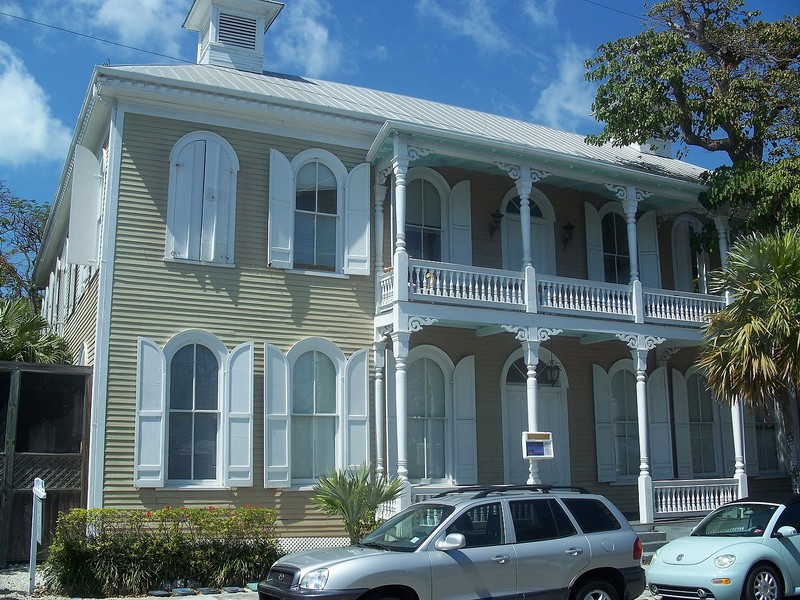Eduardo H. Gato House
Introduction
Text-to-speech Audio
Images
Eduardo H. Gato House

Backstory and Context
Text-to-speech Audio
The historic house, constructed in 1894, served as the home of Eduardo H. Gato, who migrated from Cuba in 1874 and founded an immensely successful cigar business in Key West. In fact, in 1876, Gato founded the largest cigar factory in Key West. The Gato House enjoyed inspiration from architecture typical in Cuba during the late nineteenth century. The home speaks to the extensive wealth Gato gained from his cigar enterprise, which emerged at the peak of his career, although he only occupied it briefly before returning to Cuba.
Gato was one of the thousands of Cubans that fled Cuba for Key West during the 1860s and 1870s after a failed revolution against Spain. Gato, a Cuban patriot, helped finance Cuba's notable revolutionary leaders, such as Jose Marti. He successfully established his cigar factory in Key West, using tobacco from Cuba. During the 1880s, akin to a handful of other Gilded-Age entrepreneurs, he created a nearby "city" of cottages used by his cigar workers -- Barrio de Gato, or Gatoville. The cottage city also had services and amenities used by the workers. His company played a big role, along with sponging industries, the military, and Key West's function as a port city, in turning Key West into Florida's largest and wealthiest Florida city by 1890. His historic home (circa 1894) demonstrates his success and the flourishing Key West economy around the turn of the twentieth century.
Though he returned for a period to Cuba shortly after the Spanish-American War, his and his family's influence remained a large part of Key West's growth (he eventually returned to Key West). After Gato returned to Cuba, he leased the historic home, from 1900 to 1901, to the Woman's Board of Home Missions of the Methodist Episcopal Church South. They used the house as a school until the construction of a permanent school finished in 1901. Three years later, in 1904, Cuban citizens organized a philanthropic group called Beneficencia Cubano, which first benefited indigent Cuban nationals and then eventually impoverished people throughout the world. In 1911, Beneficencia Cubano, along with Dr. Joseph N. Fogarty and Gato, established the Mercedes Hospital (Casa del Pobre) at the Gato home; the name comes from Gato's wife, Mercedes Gato. Some years later, Key West purchased the land where Gato's home stood, so Mercedes Hospital (the Gato House) was moved to another property owned by the Gato family. The hospital remained in use until World War II, when funds for the hospital proved insufficient to keep it open; the Gato family resumed ownership of the house after its closure.
Eduardo Gato eventually returned to Key West (often going back and forth between Cuba and Key West). In 1917, he built the first fireproof cigar factory. In addition to his cigar operation, Gato served as vice-president of the Key West Bank and proprietor of the Key West Street Car (a horse-drawn system). The house, which has most recently functioned as an apartment building and bed & breakfast, stands as a reminder of the Key West's and Cuba's intertwined history (along with Spain and the U.S.). Gato arrived in Key West along with thousands of Cubans after a failed revolution against Spain. He came when Key West enjoyed substantial growth, and his cigar business aided in that expansion.
Sources
De La Cova, Antonio Rafael. "Cuban Exiles in Key West during the Ten Years' War, 1868-1878." The Florida Historical Quarterly 89, no. 3 (2011): 287-319. Accessed March 8, 2021. http://www.jstor.org/stable/23035876.
Greer, Diane D. and Mary K. Evans, "Mercedes Hospital (Eduardo H. Gato House)." National Register of Historic Places. nps.gov. April 11, 1973. https://npgallery.nps.gov/GetAsset/59351324-309e-4a67-b0d2-5fa2c3970abf/.
Kravetz, Jay. "Eduardo H. Gato House." The Historical Marker Database. hmdb.com. February 6, 2017 https://www.hmdb.org/m.asp?m=101296.
Ogle, Maureen. Key West: History of an Island of Dreams. Gainesville, FL: University Press of Florida, 2006.
Wilkinson, Jerry. "History of Key West." Historical Preservation Society of the Upper Keys: Keys Historium. keyhistory.org. Accessed March 8, 2021. http://www.keyshistory.org/keywest.html.
Poyo, Gerald E. "Cuban Patriots in Key West, 1878-1886: Guardians at the Separatist Ideal." The Florida Historical Quarterly 61, no. 1 (1982): 20-36. http://www.jstor.org/stable/30146155.
By Ebyabe - Own work, CC BY-SA 3.0, https://commons.wikimedia.org/w/index.php?curid=14787153
